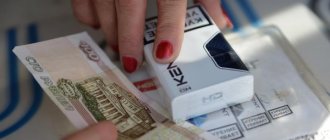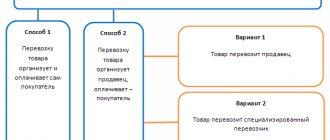Excise tax accounting. Features of accounting for excise taxes on alcohol and alcohol-containing products
The following persons are recognized as taxpayers if they carry out transactions subject to excise taxes: Organizations, individual entrepreneurs, Persons recognized as taxpayers in connection with the movement of goods across the customs border.
To reflect in accounting transactions related to excise taxes paid to suppliers of excisable goods, account 19 subaccount “Excise taxes on paid materials and valuables” is intended. Debit 19 of the account reflects the amount of excise taxes paid to the supplier for excisable goods used as raw materials for the production of excisable goods D 19 K 60 – excise tax allocation. If non-excisable products are produced from excisable raw materials, then the excise tax is not allocated, but is included in the cost of the purchased raw materials Dt 10.20 - Kt 19.
Excise goods: ethyl alcohol from all types of raw materials; alcoholic products with a share of ethyl alcohol of more than 1.5%, with the exception of wine materials; beer; tobacco products; auto and motorcycle; petroleum products; alcohol-containing with a volume fraction of alcohol over 9%.
The tax base for excise taxes is the volume, quantity, and other indicators of imported marked goods in physical terms, in respect of which fixed (specific) excise tax rates are established, or the cost of imported excisable goods, in respect of which ad valorem excise tax rates are established, or the volume of imported marked goods in in kind for calculating excise taxes when applying a fixed (specific) tax rate and the estimated cost of imported excisable goods, calculated on the basis of maximum retail prices, for calculating excise taxes when applying an ad valorem (in percentage) tax rate in relation to goods for which combined excise tax rates are established, consisting of fixed (specific) and ad valorem (percentage) rates.
The amount of excise duty on excisable goods for which fixed tax rates is calculated as the product of the corresponding tax rate and the tax base in natural units. The amount of excise duty on excisable goods for which ad valorem (in percentage) tax rates are established is calculated as the corresponding tax rate is a percentage of the tax base. The amount of excise duty on excisable goods in respect of which combined tax rates are established is calculated as the amount obtained as a result of the addition of excise duty amounts calculated as the product of a fixed tax rate and the volume of excisable goods sold in kind and as the corresponding ad valorem (in percentage) tax interest rate share of the maximum retail price of such goods. The total amount of excise tax when carrying out transactions with excisable petroleum products is determined separately from the amount of excise tax on other excisable goods.
The amount of excise tax is calculated based on the results of each tax period in relation to all transactions for the sale of excisable goods, the date of sale (transfer) of which relates to the corresponding tax period. Tax period Calendar month.
Tax deductions for excise duties are made when the following is carried out.
Deduction of input excise tax
Reflect the deduction of the excise tax amount in accounting by posting:
Debit 68 sub-account “Calculations for excise taxes” Credit 19 sub-account “Excise taxes”
– excise tax is accepted for deduction.
For information on the rules for applying excise tax deductions, see When and how excise tax can be accepted for deduction.
An example of how to reflect the deduction of input excise tax in accounting and taxation
Alpha LLC, which has a certificate for the production of denatured ethyl alcohol, sold 1,000 liters of denatured alcohol to a cosmetics production plant in February. The negotiated cost of alcohol is 177,000 rubles. (including VAT – 27,000 rubles, excise tax – 102,000 rubles). The buyer has a certificate for the production of alcohol-containing products. In April, the buyer used all the denatured alcohol received to produce alcohol-containing tincture “Cucumber” in metal aerosol packaging. Documents confirming the plant’s right to a tax deduction were submitted to the tax office in May. The excise tax rate per 1 liter of denatured alcohol is 102 rubles.
The plant accountant made the following entries in the accounting records.
In February:
Debit 10 subaccount “Raw materials and supplies” Credit 60 – 48,000 rub. (RUB 177,000 – RUB 27,000 – RUB 102,000) – denatured alcohol was received from the supplier for the production of alcohol-containing products;
Debit 19 subaccount “Calculations for VAT” Credit 60 – 27,000 rub. – input VAT is reflected;
Debit 19 subaccount “Excise taxes” Credit 60 – 102,000 rub. (1000 l × 102 rubles) – reflects the amount of excise tax presented by the supplier when purchasing denatured alcohol for the production of alcohol-containing products;
Debit 68 subaccount “Calculations for VAT” Credit 19 subaccount “Calculations for VAT” – 27,000 rubles. – input VAT is accepted for deduction;
Debit 60 Credit 51 – 177,000 rub. – paid to the supplier for denatured alcohol.
In April:
Debit 44 Credit 10 subaccount “Raw materials and materials” – 57,000 rubles. – 1000 liters of denatured alcohol were written off for the production of Cucumber tincture.
For tax accounting purposes, denatured alcohol is written off at cost, taking into account accrued excise tax, which amounts to 159,000 rubles. (RUB 57,000 + RUB 102,000). In this regard, a permanent tax asset arises in the amount of 20,400 rubles. ((RUB 159,000 – RUB 57,000) × 20%), which is reflected in the accounting records as follows:
Debit 68 subaccount “Calculations for income tax” Credit 99 – 20,400 rubles. – reflects the amount of the permanent tax asset.
In May:
Debit 68 sub-account “Calculations for excise taxes” Credit 19 sub-account “Excise taxes” - 102,000 rubles. (1000 l × 102 rubles) – excise tax related to denatured alcohol sold for the production of alcohol-containing products is accepted for deduction upon submission of supporting documents to the tax office;
Debit 68 subaccount “Calculations for income tax” Credit 99 – 20,400 rubles. – the amount of the permanent tax asset is reversed when excise tax is accepted for deduction.
How to record excise taxes in accounting?
conditions:
-Purchased goods are intended for implementation. transactions subject to excise tax.
-the amount of excise tax is actually paid to the supplier of the goods
- purchased goods must be accepted for accounting, i.e. capitalized on the balance sheet of the enterprise
— the company has documents, confirmed. Right to deduction (invoices, invoices)
In accounting, the tax deduction of excise duty is reflected by the posting: D68 K19 The accrual of excise duty on sold excisable goods in accounting is reflected in the same way as the accrual of VAT: D 90 K 68.
Features of accounting for excise taxes on alcohol products. For alcoholic products, the amount of the refundable excise tax depends on the amount of alcohol dispensed into the production. If non-excise products are produced from raw materials, then the excise tax amount is written off to cost accounts 20-19. Reimbursement of excise duty on alcoholic beverages is made on the basis of the following conditions : the alcohol is processed. The products produced are sold, the alcohol must be paid for, and the excise tax must be paid. The amount of excise tax calculated on the basis of the volume fraction of alcohol used for the production of wine materials or other products is subject to deductions. The deduction is made when the taxpayer provides the following documents to the tax authorities: purchase and sale agreement; payment documents with a bank mark; waybill and invoice; blending acts; acts for writing off wine materials in production. If excess alcohol losses occur: 91-19 excise tax write-off; 20-19 Alcoholic products are labeled specially. Federal stamps.. List of stamps. on the increase article of production, i.e. on s/s. Dt10 – Kt 60 – purchase of brand Dt19 – Kt 60; Dt 20 - Kt 10 - after selling products with the brand, the cost of the brand is included in expenses; Dt 68 – Kt 19. For alcohol-containing products, the accrual of excise duty depends on the availability of the purchaser and purchaser of the sales certificate for operations with denatured ethyl alcohol. From August 1, 2011, the excise tax rate on ethyl alcohol from all types of raw materials (including raw alcohol) and cognac alcohol depends on whether the organization pays an advance payment of excise tax (clause 1 of Article 193 of the Tax Code of the Russian Federation). Thus, when shipping or transferring alcohol within one organization, producers of alcoholic or alcohol-containing products who pay an advance payment are provided with a zero excise tax rate. The same rate is applied by manufacturers of perfumes, cosmetics and household chemicals in metal aerosol packaging.
If manufacturers use alcohol-containing products as raw materials, the amount of deduction will be less than the amount of excise tax actually paid when purchasing alcohol-containing products. In this case, the amount of deduction will be determined based on the excise tax rate on ethyl alcohol. Excise tax rate on alcohol-containing products. set at the same level as the excise tax rate on alcohol products with a volume fraction of ethyl alcohol up to 9%. Payment of excise duty upon the sale (transfer) by taxpayers of excisable goods produced by them is made based on the actual sale (transfer) of goods for the expired tax period no later than the 25th day of the month following the expired tax period. Taxpayers are required to submit a tax return to the tax authorities at their location and at the location of separate divisions no later than the 25th day of the month following the expired tax period.
The excise tax amount is calculated by applying the established excise tax rate to the tax base.
The amount of excise tax on the gambling business is calculated by applying the excise tax rate established for the tax period to the number of objects of taxation.
If the number of taxable objects changes in the tax period, the amount of excise tax on the introduced (retired) object is paid in full;
For excisable goods produced from customer-supplied raw materials and materials, excise duty is paid on the day the product is transferred to the customer or the person specified by the customer.
When transferring crude oil or gas condensate produced on the territory of the Republic of Kazakhstan for industrial processing, excise tax is paid on the day of its transfer .
Excise taxes on other excisable goods are subject to transfer to the budget no later than:
1) on the thirteenth day of the month for transactions made during the first ten days of the tax period;
2) on the twenty-third day of the month for transactions made during the second ten days of the tax period;
3) on the third day of the month following the reporting month, for transactions completed during the remaining days of the tax period.
When producing excisable goods from own raw materials, which are subject to excise duty, the excise tax on these raw materials is paid within the time limits established for the payment of excise duty on finished excisable goods.
The excise tax on the gambling business is paid in conjunction with a fixed total tax (patent) monthly later than the 20th day of the month following the reporting one.
Accounting algorithms for excise taxes on operations with straight-run gasoline
Accounting for excise taxes when carrying out operations with straight-run gasoline (PG) is carried out:
- PB manufacturer,
- buyer of PB.
Excise tax is paid by the manufacturer of industrial products
The accounting algorithms are based on the following conditions:
- the manufacturer of industrial products charges excise tax when selling industrial products in the Russian Federation;
- the moment of accrual of excise duty is the day of shipment of the industrial product to the buyer;
- for the calculation of excise tax, the presence or absence of a certificate of registration of the person performing transactions with the food product at the manufacturer of the product does not matter;
- The amount of excise tax on industrial goods (APB) is determined by the formula:
APB = VPB × SAPB,
Where:
VPB—volume of sold PB in tons;
SAPB is the excise tax rate for 1 ton of PB.
Accounting for the excise tax accrued by the manufacturer of a food product depends on the presence or absence of a certificate for the production of food products.
Certificate available
- The presence of a certificate allows the manufacturer of PB to deduct the calculated excise tax: if the PB is sold to a company that has a certificate for processing PB;
- if the manufacturer of PB transfers PB to the owner of the raw materials used in its production, and if the owner subsequently sells PB to a company that has a certificate for processing PB.
| Debit | Credit |
| Accrual of excise duty on the sale of industrial goods |
No certificate
The absence of a certificate requires the manufacturer of the protective equipment:
- excise tax to be presented to the buyer,
- highlight the accrued excise tax in the documents.
In this case, it does not matter whether the buyer has a certificate for processing PB.
The following is recorded in accounting:
| Debit | Credit |
| 90.4 (91.2) | Accrual of excise tax on the sale of industrial goods (excise tax is taken into account by the debit of the account in which the amounts of proceeds from the sale of industrial goods are recorded) |
A similar scheme for reflecting excise tax is applied if:
- the buyer of PB does not have a certificate for processing PB;
- the purchased PB will not be used for the production of petrochemical products.
Excise tax is paid by the buyer of the PB
The buyer has an obligation to charge excise duty if:
- the company has a certificate for processing PB;
- the received PB belongs to her by right of ownership.
In accounting, excise tax must be charged to the buyer when purchasing industrial goods (at the time of its capitalization):
| Debit | Credit |
| Accrual of excise tax upon receipt of industrial goods |
Reflection of income from industrial goods and excise tax amounts depends on the intention of the company. For example, if a company intends to use the resulting industrial product as a raw material for the manufacture of petrochemical products within the company, excise tax is not charged, and the following is recorded in accounting:
| Debit | Credit |
| PB received from the supplier as a raw material for the production of petrochemical products was capitalized |
The subsequent write-off of PB in the form of raw materials for the manufacture of petrochemical products does not require the inclusion of accrued excise tax in the cost of consumed PB - it is accepted for deduction (if there are all documents confirming the fact of transfer of PB to production).
The following entries are made in accounting:
| Debit | Credit |
| Reflection of the deduction for excise tax accrued upon receipt of industrial goods |
If the purpose of acquiring the industrial product is not the manufacture of petrochemical products, the excise tax accrued upon receipt of the industrial product is included in its cost:
| Debit | Credit |
| The cost of industrial goods includes the excise tax accrued upon its acquisition. |
In a situation where a company does not have a certificate for processing PB, the following accounting algorithm applies:
- excise tax is not charged upon receipt of industrial goods;
- The manufacturer of the industrial product does not have the right to an “excise” deduction, so he includes the excise tax in the price of the sold industrial product and presents it to the buyer.
Service Temporarily Unavailable
If the payer has several gambling establishments in the region (city), the excise tax is paid separately for each facility.
Excise tax on the activities of organizing and conducting lotteries is paid before or on the day of registration of the issue of the sale of lottery tickets.
Payment of excise tax is made at the place of registration of the excise payer, with the exception of the following cases.
Excise tax payers who have structural divisions pay excise tax at the location of the structural divisions in the prescribed manner if they:
1) production of alcoholic products and all types of alcohol and (or) bottling them;
2) carry out wholesale and retail sales of gasoline (except for aviation) and diesel fuel.
1. At the end of each tax period, the taxpayer is obliged to submit an excise tax declaration to the tax authorities at the place of his registration no later than the 20th day of the month following the tax period.
2. Excise tax payers who have structural units simultaneously with the declaration submit excise tax calculations for structural units.
3. The declaration and calculations for excise duty for structural units are submitted to the tax authority no later than the 20th day of the month following the tax period.
Deadlines for paying excise duty on imported excisable goods
Excise taxes on imported goods are paid on the day determined by the customs legislation of the Republic of Kazakhstan for the payment of customs duties.
Excise duty on imported excisable goods subject to marking is paid before or on the day of receipt of excise stamps.
When actually importing excisable goods, the amount of excise tax is subject to clarification.
| Debit | Credit | Contents of business transactions | Source documents |
| Excise taxes are assessed when petroleum products are received by an organization that has a certificate. | Invoices | ||
| 90-2 | 19, 41 | Excise tax has been assessed on the transfer of petroleum products to persons who do not have a certificate. | Invoices |
| Excise taxes are presented for deduction when transferring petroleum products to persons who do not have a certificate. | Invoices | ||
| 41, 43 | Excise taxes are accrued when an organization that does not have a certificate takes into account oil products produced independently or received as payment for services related to their production. | Invoices | |
| Excise taxes have been accrued on advance payments received for the upcoming shipment of products (goods), the date of sale of which for the purpose of calculating excise taxes is the date of payment. | Invoices | ||
| The amount of excise tax is deducted from the advance payment upon shipment of products (goods). | Invoices | ||
| 90-4 | Excise taxes are charged on the sale of excisable goods. |
Export of goods
The accrual of excise duty on export supplies in the event that a bank guarantee (Article 74 of the Tax Code of the Russian Federation) or a bank guarantee is not submitted to the tax office, reflect the following posting:
Debit 68 subaccount “Excise tax for reimbursement on export supplies” Credit 68 subaccount “Calculations for excise taxes”
– excise tax is charged on unconfirmed export supplies.
After submitting documents confirming the fact of export of excisable goods to the tax inspectorate, reflect the return of previously accrued tax by posting (clause 3 of Article 184 of the Tax Code of the Russian Federation):
Debit 68 subaccount “Calculations for excise duties” Credit 68 subaccount “Excise duty for reimbursement on export supplies”
– excise tax is accepted for deduction upon confirmation of export.
If export is not confirmed in the future, then the previously accrued excise tax is written off as expenses not taken into account when calculating income tax:
Debit 91-2 Credit 68 subaccount “Excise duty for reimbursement on export supplies”
– excise tax on unconfirmed export supplies is written off for other expenses;
Debit 99 Credit 68 subaccount “Calculations for income tax”
– a permanent tax liability is reflected.
Accounting entries for excise taxes
Invoices91-2 Excise taxes are accrued upon the transfer of excisable products as a contribution under a simple partnership agreement (joint activity) or a contribution to the authorized capital of other organizations. Invoices Excise taxes are accrued upon the transfer of natural gas for processing on a toll basis and (or) in the structure of the organization for manufacture of other types of products. Invoices Accrued excise taxes on the use of excisable products for one's own needs in the main production. Invoices Accrued excise taxes on the transfer of natural gas for use for one's own needs in the main production. Invoices Transferred excise taxes to the budget. Payment order (0401060), Bank statement on current account.Accounting entries for accounting for payments for the use of natural resources
| Debit | Credit | Contents of business transactions | Source documents |
| 20, 23, 25, 26 | Fees have been charged for the use of water resources. | Tax return for fees for the use of water bodies, Accounting certificate. | |
| Fees for the use of water resources are listed. | Payment order (0401060), Bank statement on current account. | ||
| 20, 23, 25, 26 | A fee has been charged for the negative impact on the environment. | Accounting information | |
| A fee for negative impact on the environment is listed. | Payment order (0401060), Bank statement on current account. |
Accounting entries for accounting for mineral extraction tax
| Debit | Credit | Contents of business transactions | Source documents |
| 20, 23, 25, 26 | Mineral extraction tax accrued | Tax return for mineral extraction tax, Accounting certificate. | |
| Advance payments for mineral extraction tax have been paid. | Payment order (0401060), Bank statement on current account. | ||
| Mineral extraction tax has been paid. | Payment order (0401060), Bank statement on current account. |
Accounting entries for accounting for regional taxes and fees
| Debit | Credit | Contents of business transactions | Source documents |
| 91-2 | Property tax has been assessed. | Tax return for property tax, Accounting certificate. | |
| Property tax has been paid. | Payment order (0401060), Bank statement on current account. | ||
| Transport tax has been charged. | Tax return for transport tax, Accounting certificate. | ||
| Transport tax has been paid. | Payment order (0401060), Bank statement on current account. | ||
| 91-2 | Regional licensing fees have been assessed. | Accounting information. | |
| Regional license fees have been paid. | Payment order (0401060), Bank statement on current account. |
Date added: 2017-01-21; | Copyright infringement
Recommended content:
Related information:
Search on the site:
“Excise” entries when transferring excisable goods to a structural unit
If a structural unit of a company is allocated to a separate balance sheet and PT for the manufacture of non-excisable goods is transferred to it, the following entries are made in accounting:
| Debit | Credit |
| The transfer of PT produced by the company to its division is reflected | |
| Accrual of excise duty when transferring PT to your division for the manufacture of goods that are not classified as excisable |
Find out what you need to know when opening a separate division from the articles posted on our portal:
“Registration of a separate division - step-by-step instructions 2016”;
“We are opening a separate division under the simplified tax system.”
If the division is not allocated to a separate balance sheet, the accounting entries will be different:
| Debit | Credit |
| The transfer of PT to the unit is reflected | |
| Accrual of excise tax upon transfer of PT to a unit |
PT can be used not only for the manufacture of products, but also for its internal needs. In such a situation, the excise tax, together with the cost of spent PT, is taken into account as part of expenses for ordinary activities (clauses 5, 7 of PBU 10/99):
| Debit | Credit |
| (23, 26…) | The transfer of PT to a unit for its own needs is reflected |
| (23, 26…) | Accrual of excise tax upon transfer of PT to a unit for its own purposes |
Budget payments, taxes and fees
Accounting for value added tax calculations.
To reflect in the accounting of business transactions related to VAT, accounts 19 “Value added tax on acquired assets” and 68 “Calculations for taxes and fees”, subaccount “Calculations for value added tax” are intended.
Account 19 has the following subaccounts:
- 19-1 “Value added tax on the acquisition of fixed assets”;
- 19-2 “Value added tax on acquired intangible assets”;
- 19-3 “Value added tax on purchased inventories.”
In the debit of account 19 for the corresponding subaccounts, the customer organization reflects the tax amounts on purchased material resources, fixed assets, intangible assets in correspondence with the credit of accounts 60 “Settlements with suppliers and contractors”, 76 “Settlements with various debtors and creditors”, etc.
For fixed assets, intangible assets and inventories, after they are registered, the amount of VAT recorded on account 19 is written off from the credit of this account depending on the direction of use of the acquired objects to the debit of the accounts:
- 68 “Calculations for taxes and fees” - for production use; accounting for sources of covering costs for non-productive needs (29, 91, 86) - when used for non-productive needs;
- 91 “Other income and expenses” - when selling this property.
Tax amounts on fixed assets, intangible assets, other property, as well as on goods and material resources (work, services) to be used in the manufacture of products and operations exempt from tax are written off as a debit to production cost accounts (20 “Basic production", 23 "Auxiliary production", etc.), and for fixed assets and intangible assets - taken into account along with the costs of their acquisition.
When selling products or other property, the calculated tax amount is reflected in the debit of accounts 9012021087 “Sales” and 91 “Other income and expenses” and the credit of account 68, subaccount “Calculations for value added tax” (for sales “on shipment”), or 76 “Settlements with various debtors and creditors” (when selling “on payment”). When using account 76, the amount of VAT as a debt to the budget will be accrued after the buyer pays for the products (debit account 76, credit account 68). Repayment of debt to the budget for VAT is reflected in the debit of account 68 and the credit of cash accounting accounts.
Accounting for excise taxes, income taxes, property taxes and personal income taxes
Excise tax accounting is carried out basically in the same way as VAT accounting using accounts 19 and 68.
When calculating income tax, account 99 “Profits and losses” is debited and account 68 “Calculations for taxes and fees” is credited. Tax penalties due are recorded in the same accounting entry. The listed amounts of tax payments are written off from the current account or other similar accounts to the debit of account 68.
Accounting for personal income tax. The procedure for calculating and paying this tax is discussed in Chapter 12, and the procedure for accounting for the unified social tax is also set out there (see clause 12.8).
Property tax accounting. Accounting for settlements of organizations with the budget for corporate property tax is kept on account 68 “Calculations for taxes and fees”, in the subaccount “Calculations for property tax”.
The accrued tax amount is reflected in the credit of account 68 “Calculations for taxes and fees” and the debit of account 91 “Other income and expenses”. The transfer of the amount of property tax to the budget is reflected in accounting as the debit of account 68 “Calculations for taxes and fees” and the credit of account 51 “Current account”.
Sales tax accounting.
Sales tax is calculated using the following accounting entry:
Debit account 90 “Sales” | Credit to account 68 “Calculations for taxes and fees”, | subaccount “Sales tax calculations” |
The transfer of sales tax to the budget is reflected in the debit of account 68 from the credit of cash accounting accounts.
What are middle distillates?
Middle distillates are some types of petroleum products that are obtained by distilling hydrocarbons. In particular, these include heating and marine fuels. They are excisable goods (subclause 11, clause 1, article 181 of the Tax Code of the Russian Federation).
Middle distillates are mixtures of hydrocarbons in a liquid state that simultaneously correspond to two indicators:
- density 750 - 930 kg/cubic. m at a temperature of 20°C;
- end distillation temperature 215 - 360°C (this is the temperature at which at least 90 percent of the mixture is distilled at an atmospheric pressure of 760 mm Hg).
Such characteristics of middle distillates are given in subclause 11 of clause 1 of Article 181 of the Tax Code of the Russian Federation and are valid until 04/01/2020.
When checking, the tax office may require confirmation that the fuel is a middle distillate. The documents that must be provided in this case are not established by the Tax Code of the Russian Federation. The main thing is that it is clear from them that the fuel with which the operations were performed has physical and chemical characteristics corresponding to middle distillates.
How does the recipient pay excise tax?
A Russian organization that has received (purchased) middle distillates is required to charge excise tax if:
- she has a certificate of registration of an organization performing operations with middle distillates;
- it acquired middle distillates as property under an agreement with a Russian organization (subclause 29, clause 1, article 182 of the Tax Code of the Russian Federation).
The acquisition of middle distillates into ownership can be confirmed by a sales contract, delivery note, and other documents.
The excise tax must be calculated on the date of receipt of middle distillates (paragraph 8 of Article 195 of the Tax Code of the Russian Federation).
The amount of excise tax is calculated according to the formula (clause 11 of article 187, clause 1 of article 194 of the Tax Code of the Russian Federation):
| Excise tax amount | = | Volume of middle distillates produced (tons) | X | Current excise tax rate for 1 ton of middle distillates |
Excise tax deduction
The amount of excise tax accrued upon receipt of middle distillates is not included in the cost of these excisable goods (subclause 6, clause 4, article 199 of the Tax Code of the Russian Federation). This excise tax amount can be deducted with a coefficient of 2 or 1.
A deduction with a coefficient of 2 is possible if middle distillates are used for bunkering (refueling) of objects for which a certificate has been obtained. These are water vessels, installations and structures specified in paragraph 1 of Article 179.5 of the Tax Code of the Russian Federation.
It is necessary to charge excise tax upon receipt of middle distillates if the buyer has a certificate of registration of an organization performing transactions with middle distillates (subclause 29, clause 1, article 182 of the Tax Code of the Russian Federation).
This excise tax can be deducted with a coefficient of 2 if the requirements of paragraph 22 of Article 200 of the Tax Code of the Russian Federation are met. The main requirement is that middle distillates are used for bunkering (refueling), in particular, facilities that:
- used for shipping or merchant shipping;
- fly under the State Flag of the Russian Federation;
- belong to the organization by right of ownership or right of possession, use or disposal.
A deduction is possible if there are documents listed in paragraph 22 of Article 201 of the Tax Code of the Russian Federation.
A deduction with a coefficient of 1 is applied if the resulting middle distillates are used not for bunkering objects, but for other purposes. For example, during resale.
Documents for deduction
To receive a deduction, you must attach supporting documents to your excise tax return for the period in which it is declared.
To deduct with a coefficient of 1 you need to have:
- a copy of the registration certificate of an organization carrying out operations with middle distillates;
- a copy of the contract for the supply (purchase and sale) of fuel, which is classified as middle distillates, with the Russian supplier organization.
These documents will also be needed for a deduction with a coefficient of 2. But in addition to them, for a double deduction, you need confirmation that middle distillates were used for bunkering the objects listed in Article 179.5 of the Tax Code of the Russian Federation.
Amendments to the definition of middle distillates
Federal Law No. 255-FZ of July 30, 2019 (hereinafter referred to as Law No. 255-FZ) from this date introduced amendments to the Tax Code of the Russian Federation, according to which, from April 1, 2020, middle distillates are mixtures of hydrocarbons in the liquid or solid state (at a temperature of 20 ° C and atmospheric pressure of 760 millimeters of mercury) obtained as a result of primary or secondary oil refining, the density values of which do not exceed 1.015 kg/cubic. m.
Middle distillates will include all dark petroleum products, some of which are not yet recognized as excisable goods or are separated into a separate category, including fuel oil.
Let us remind you that until April 1, 2020, the upper limit of density in the definition of middle distillates is 930 kg/cubic. m, and this is less than the characteristic density of fuel oil.
The concept of “dark marine fuel” and, accordingly, the taxable object and deduction associated with it are excluded.
Amendments to the deduction procedure
Law No. 255-FZ, in order to curb the tax burden on heat and electricity supply organizations, provides deductions with a coefficient of 2 for buyers using middle distillates as fuel for the production of heat and electricity.
Consumers of fuel oil will also be able to receive a tax deduction for excise duty on middle distillates if they obtain an excise tax payer’s certificate and prove its intended use as boiler or bunker fuel. In order to deduct the excise tax assessed by the seller, they will have to charge the excise tax a second time, after which they will be able to receive a double deduction. As a result, the cost of fuel will be returned to its original value before the excise tax is charged by the seller.
Let us remind you that now coefficient 2 is applied only when used for bunkering ships.
Payers
Excise tax payers are legal entities and individuals who:
- Produce excisable goods in the Republic of Kazakhstan;
- Import excisable goods into the Republic of Kazakhstan;
- They sell gasoline and diesel fuel on the territory of the Republic of Kazakhstan
- Persons selling excisable goods for which payment of excise duty has not been confirmed, etc.
In the “Accounting 8 for Kazakhstan” configuration, the sign that an organization or individual is an excise tax payer is set in the information register Accounting policy (tax accounting)
, which is available in the section
Enterprise
-
Accounting Policies
.
To do this, on the main tab you need to set the Excise Tax Payer
.






